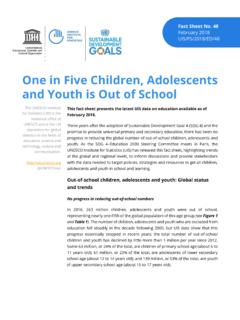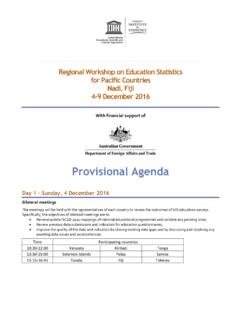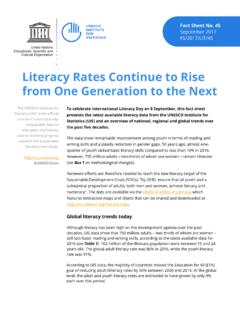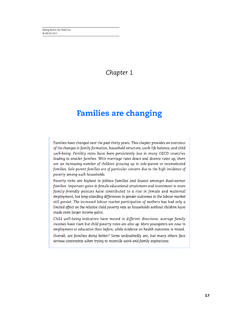Transcription of New Methodology Shows that 258 Million Children ...
1 Fact Sheet no. 56. September 2019. UIS/2019/ED/FS/56. New Methodology Shows that 258 Million Children , Adolescents and Youth Are Out of school As the custodian agency This fact sheet presents the latest UIS data on education available as of for SDG 4 data, the UNESCO Institute September 2019. for Statistics develops the indicators and Three years after the adoption of Sustainable Development Goal 4 (SDG 4) and the methodologies needed promise to provide universal primary and secondary education, there has been no to track progress progress in reducing the global number of out-of- school Children , adolescents and towards international education goals.
2 Youth. This fact sheet by the UNESCO Institute for Statistics (UIS) highlights the most recent statistics on trends at the global and regional levels, based on a revised @UNESCO stat calculation method that provides more precise estimates of the out-of- school population. Out-of- school Children , adolescents and youth: Global status and trends No progress in reducing out-of- school numbers In 2018, Million Children , adolescents and youth were out of school , representing one-sixth of the global population of this age group (see Figure 1 and Table 1). This number is Million lower than the number of out-of- school Children released by the UIS in September 2018 ( Million ).
3 Most of this reduction is due to a change in the Methodology used to calculate the number and rate of out-of- school Children . Until 2018, Children enrolled in pre-primary education were included in the count of out-of- school Children . Starting in 2019, any Children enrolled in formal education, regardless of the level, are considered to be in school , including Children of primary school age enrolled in pre-primary education (see Box 1). The change in the calculation method did not affect the overall trend in out-of- school figures, which still points towards stagnation in recent years.
4 The number of Children , adolescents and youth who are excluded from education fell steadily in the decade following 2000, but UIS data show that this progress has basically stopped in recent years; the total number of out-of- school Children and youth has declined by little more than 1 Million per year since 2015. Some 59 Million , or 23% of the total, are Children of primary school age (about 6 to 11 years old); 62 Million , or 24% of the total, are adolescents of lower secondary school age (about 2 UIS Fact Sheet No. 56 | September 2019. 12 to 14 years old); and 138 Million , or 53% of the total, are youth of upper secondary school age (about 15.)
5 To 17 years old). The rates of out-of- school Children , adolescents and youth have followed a similar trend (see Figure 2). After an initial decline in the years after 2000, the primary out-of- school rate has decreased only slightly since 2008, reaching 8% in 2018, and the lower secondary out-of- school rate has been at 16% since 2012. The upper secondary out-of- school rate, which was initially at much higher levels than the primary and lower secondary out-of- school rates, has fallen more steadily since 2000, reaching 35% in 2018. Upper secondary school -age youth are more than four times as likely to be out of school as Children of primary school age and more than twice as likely to be out of school as adolescents of lower secondary school age.
6 The high out-of- school rates for older cohorts can be explained by poverty and a variety of other reasons: many youth never had a chance to enter school when they were younger, upper secondary education is often not compulsory, and upper secondary school -age youth may choose employment over continuing their education (UIS and GEMR, 2016). 3 UIS Fact Sheet No. 56 | September 2019. 4 UIS Fact Sheet No. 56 | September 2019. Table 1. Out-of- school rates and numbers by SDG region, 2018. Out-of- school Children of primary school age Out-of- school rate (%) Out-of- school number (millions).
7 Region Both sexes Male Female GPIA Both sexes Male Female Europe and Northern America Latin America and the Caribbean Central Asia Southern Asia Eastern and South-Eastern Asia Northern Africa and Western Asia Sub-Saharan Africa Oceania World Out-of- school adolescents of lower secondary school age Out-of- school rate (%) Out-of- school number (millions). Region Both sexes Male Female GPIA Both sexes Male Female Europe and Northern America Latin America and the Caribbean Central Asia Southern Asia Eastern and South-Eastern Asia Northern Africa and Western Asia Sub-Saharan Africa Oceania World Out-of- school youth of upper secondary school age Out-of- school rate (%) Out-of- school number (millions).
8 Region Both sexes Male Female GPIA Both sexes Male Female Europe and Northern America Latin America and the Caribbean Central Asia Southern Asia Eastern and South-Eastern Asia Northern Africa and Western Asia Sub-Saharan Africa Oceania World Out-of- school Children , adolescents and youth of primary, lower secondary and upper secondary age Out-of- school rate (%) Out-of- school number (millions). Region Both sexes Male Female GPIA Both sexes Male Female Europe and Northern America Latin America and the Caribbean Central Asia Southern Asia Eastern and South-Eastern Asia Northern Africa and Western Asia Sub-Saharan Africa Oceania World Notes: GPIA = adjusted gender parity index (female/male out-of- school rate).
9 Male and female out-of- school numbers may not add up to the total number because of rounding. Source: UNESCO Institute for Statistics database. 5 UIS Fact Sheet No. 56 | September 2019. Box 1: Definition of the out-of- school rate The calculation method for the out-of- school rate has evolved over time. Before 2005, the primary out-of- school rate was derived from the primary net enrolment rate, the proportion of the population of primary school age enrolled in primary education. Under this approach, only Children of primary school age in primary education were considered in school .
10 This meant that primary-age Children in secondary education were counted as part of the out-of- school population. In 2005, a joint publication by the UIS and UNICEF described a new calculation method for the out-of- school rate. According to the revised Methodology , Children of primary school age are counted as being in school when they are participating either in primary or secondary education (UIS, 2005). However, Children of primary school age in pre- primary education continued to be counted as out of school . The 2005 report gave two reasons for this. First, on the background of the Millennium Development Goal of universal primary education, the content of pre-primary education was not seen as always appropriate for Children of primary school age.


















